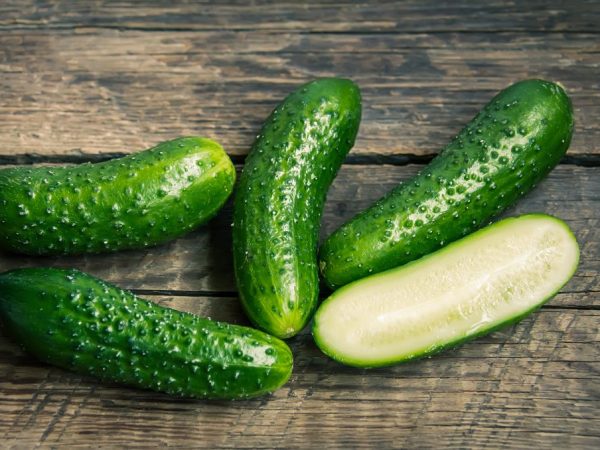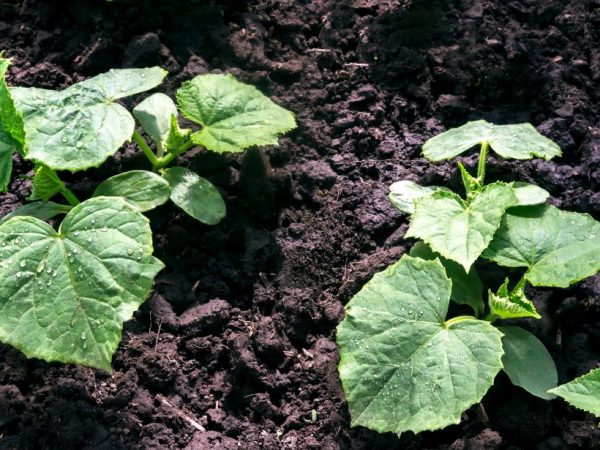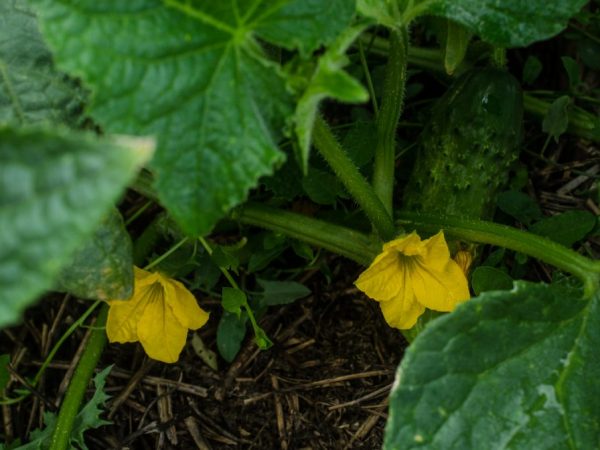Characteristics of the cucumber variety Libelle F1
Libelle F1 cucumbers are the fruit of long selection efforts. They attract the attention of gardeners primarily with minimal maintenance costs and good taste.

Characteristics of the cucumber variety Libelle F1
According to the description, the variety is distinguished by its early maturity and high yield, which makes it competitive in the market. The unpretentiousness of the variety allows you to grow it even in unsuitable climatic conditions.
Description of the variety
The Libella cucumber is a parthenocarpic hybrid. This is a long-leaved plant, the length of the fruit ranges from 11 to 15 cm, its surface is covered with small tubercles. The shape of the cucumbers is elliptical. The average weight reaches 120 g.
The pulp is crispy, there is no bitterness. Harvesting is carried out 2 months after planting seeds or seedlings. The ovaries are formed in the form of bunches. The maximum yield for this variety is 10 kg of fruit per 1 m².
Advantages and disadvantages
The hybrid origin gives the Libella variety many positive qualities. Among them are noted:
- great fruit taste;
- high productivity.
Ogorodnikov variety wins over with good keeping quality and presentation.
Despite the positive characteristics, the variety also has negative characteristics. With an incorrect watering regime or an overdose of mineral components, the fruits have a bitter taste. Also, cucumbers quickly outgrow, so harvesting must be prompt.
Planting methods
There are several ways to carry out seed growing. These include:
- landing in open ground;
- the use of trellises;
- greenhouse method.
Most often, the cucumber Libella F1 is planted using seedlings. To do this, germinate seeds 3-4 weeks before planting on the site. The seedlings are kept in a warm place, and the air circulation is monitored. Seedlings do not tolerate drafts well.
Seeds covered with a colored film can be planted in the ground without prior germination. A similar method is used if the soil is rich in mineral components.
Landing in open ground

Prepare the soil for planting
Using this method, seedlings or seeds are planted directly on the site, having previously cultivated a bed. The soil for cultivation must be loose. The dense top ball does not allow water to pass through well, so plants die from drought.
Excess moisture and acidic soil also have a negative effect on the growth of Libella F1 cucumbers. First of all, the roots and taste of future fruits suffer from such factors.
The cultivation of this culture is recommended to be carried out on the site where potatoes or tomatoes grew a year earlier. The cucumber variety Libella F1 produces a good harvest on soil that contains phosphorus, potassium and nitrogen. The lack of these nutrients can be replenished at home with a mixture of humus, ash and sand.
Planting is carried out only in the warm season, the slightest frost causes crop failure. The average temperature per day should not be lower than 14 ° C.
Tapestry method
The trellis structure makes it much easier to care for the bushes, in addition, the netting on the net helps the stems to receive the same amount of sunlight. The frame of the product must be strong and well driven into the ground. A loosely secured structure can fall under the influence of precipitation and injure the cucumber lashes.
They use wooden blocks or metal pipes as a basis. Next, a trellis net is pulled onto the frame, which is fixed with twine. The height of the ray should be 2 m.
The seedlings under the trellis are fertilized and hilled as they grow. As soon as the height of the bush reaches 30 cm, it is pruned.
Greenhouse method
Only high quality seeds are germinated in greenhouses. The criterion for determination is the brightness and integrity of the color film. A distance of 50 cm is maintained between the rows, otherwise heaped bushes will give a weak harvest. In greenhouse conditions, the lashes must be tied so that they grow vertically.
Bush care
During the period of active growth, the cucumber Libella F1 needs a set of actions aimed at stimulating the vegetation. These include:
- correct watering;
- fertilization of plants;
- the formation of bushes.
The space between the rows must be mulched. For this, organic materials are used. Also, seedlings require regular weeding. Weeds consume a lot of moisture, which is why the fleshiness of the fruit suffers.
Watering

The plant needs regular watering
Regulation of water supply is a guarantee of high taste qualities of cucumbers. In greenhouse conditions, the soil is watered once a week. The amount of watering during open planting is influenced by the amount of precipitation and the growing season:
- before flowering on 1 m², 6 liters are applied during a dry campaign and 3 liters after rain once a week;
- during the ripening period, cucumbers are watered every 3 days, 10 liters in dry weather and 6 liters after precipitation.
When watering, make sure that water does not get on the foliage and weaving of bushes. This can cause the appearance of fungal diseases.
Warm, settled water is suitable for irrigation. The procedure itself is best carried out in the evening, so that the earth is saturated with moisture overnight. After precipitation or watering, the soil is loosened, otherwise the upper ball becomes covered with a dense crust and the water stops evaporating.
Top dressing
Fertilize cucumbers at a temperature of at least 18 ° C. During the period of active growth, the culture requires the introduction of a mineral complex that contains nitrogen and potassium. During the ripening of the fruit, phosphorus supplements are added.
There are several types of dressings that can be prepared at home. These include:
- onion peel infused with water;
- a mixture of whey and iodine;
- diluted chicken droppings or mullein.
If the soil was fertilized with organic components in the fall, the plants do not require additional feeding during the growing season. An excess of nutrients will add bitterness to the cucumbers. In particular, too much nitrogen leads to a change in the shape of the fruit.
Bush formation
Cucumber Libella F1 needs to form a bush during the active growing season. Often, an excess of lashes causes a small yield and small fruit size due to improper distribution of sunlight.
To avoid this, excess shoots are cut off. However, it is not recommended to injure the central stem and the initial lateral shoots.
Pest control
Due to its hybrid origin, the variety is resistant to fungal and bacterial diseases, but additional prevention helps to strengthen the plant's immunity. Early maturity does not allow the lash to be treated with heavy chemicals, since the fruits can become toxic to humans. However, you can use homemade solutions:
- Powdery mildew is vulnerable to a mixture of iodine, dairy, and soap. Add 10 drops of iodine, 1 liter of milk or whey and 1 spoonful of soap to a bucket of water. Cucumber foliage is treated with this solution.
- To prevent gray rot, use water with the addition of baking soda.
- Bacteriosis can be defeated with 2 Trichopolum tablets diluted in 1 liter of water.
Among harmful insects, the greatest threat to the variety is spider mites and slugs. To get rid of pests, the site is dug up in the fall, without breaking large clods. This causes the death of weeds and larvae.
Also, insects cannot stand the smell of garlic and onions. Many pests are repelled by dill, which can be sown between rows.
Conclusion
The description of the Libelle variety includes many worthy qualities. Positive characteristics include high yield and disease resistance.
The hybrid origin makes this type of cucumber easy to care for. The main feature of the fruits is their early maturity, therefore it is dangerous to overexpose them even for a couple of days.

